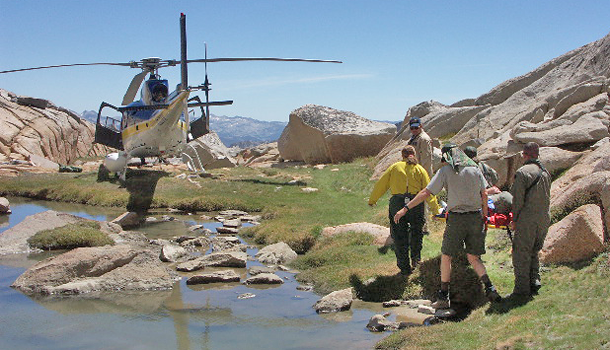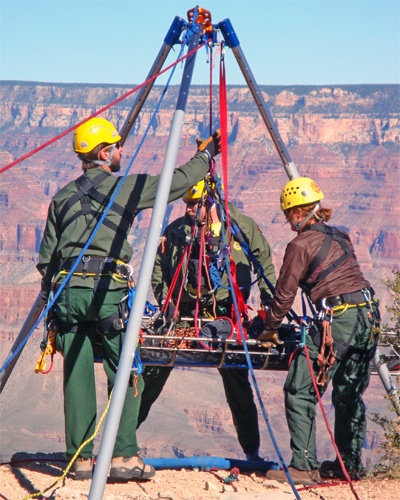
Offering care and calm in the wild
Wednesday 8 August 2012
Doctors at a UCSF Fresno program don't just provide emergency care to those who become sick or injured in the backcountry. They research lifesaving techniques and have become leading specialists in wilderness medicine.
On a September day, a tall, athletic man begins his descent of 14,000-foot Mount Tyndall in the Sequoia National Park. The mountain is deep into the park — part of the stately line of peaks that frames the east side of the Sierra.
He’s alone just after lunch and perhaps a little tired. He slips, tumbling 25 feet and fracturing his femur — a potentially deadly break of the largest bone in the human body.
For two hours he waits for help until a woman hears his calls and rushes back to the trailhead, where she seeks assistance just before midnight. When she calls, a well-oiled machine slips into gear. At dawn, a search and rescue helicopter takes off with two park medics trained in the latest wilderness first-aid techniques.
By 11:a.m., they find him on an exposed ledge, still alive, but dangerously cold. They can’t get an airlift for the rest of the day and by nightfall he is getting worse. So one rescuer waits while the other goes to radio the base, which forwards the call to the regional emergency and trauma center in Fresno.
“That’s part of the difficulty of wilderness care: You don’t always have all the supplies or you may be in a tight environment where you can’t do what you might do here on the streets of Fresno,” said Lori Weichenthal, wilderness medicine director at the UCSF Fresno Medical Education Program. “It was too late in the evening for the helicopter to actually rescue him. So she (the rescuer) basically spent the night hung over a mountain with this guy.

The emergency center, a program of UCSF, is perhaps the best place in the country to receive a distress call from 14,000 feet up a mountain. The doctor on call immediately orders a saline IV drip for the struggling patient. It’s a complicated move for rangers, but these medics can do it, since UCSF Fresno trains almost all the backcountry medics in the Sierras, including these rescuers.
The man’s condition improves and the team works through the night. The next day, with the help of a burly National Guard Blackhawk helicopter, the patient enters the Fresno hospital 53 hours after his fall and fully recovers.
Started in the early 1970s, the UCSF Fresno program was one of the country’s first designed specifically for emergency medicine. More recently, it has become one first in the country with specialists in wilderness emergency medicine, using its proximity to the Sierra as a testing ground for saving lives in the backcountry. Today, medics from the Sierra to the Grand Canyon call UCSF Fresno for direction during emergencies.
“Unlike a lot of wilderness medicine programs, we actually have a wilderness. It’s called the Sierra Nevada,” said Jim Comes, director of emergency medicine. “If you are injured in Sequoia Kings Canyon there’s going to be a park medic in the backcountry who is going to be calling us on the radio, and we are going to be guiding their care.”
Since its inception, the UCSF Fresno program has cut its own trail in the medical world. As the only major trauma center in the Central Valley, it’s among the busiest emergency rooms in the state, with gangland shootings, agricultural accidents and just about any kind of misfortune that can happen in the mountains.
“There are trauma centers in Stanford and in San Francisco. But they don’t see the same volume; they don’t see the same type of injuries that we see,” says Comes.
UCSF Fresno doctors have treated rattlesnake bites, high altitude edemas and a Yosemite rock climber who fell 300 feet and miraculously survived. In another case, during a particularly nasty storm, three Boy Scouts were struck by lightning near Mount Whitney. When he got to the ER, one of the boys still carried a rarely-seen lacy pattern on his back called a “Lichtenberg figure” that looks like a giant tree tattoo.
“This person was sitting there in the hallway with these lightning patterns of red traced across his body,” says Susanne Spano, a medical resident at the time who now works and conducts research at the program. “Educationally it was unparalleled. This might be the only time in your life you are ever going to see this.”
But the young doctors from around the country don’t line up every season just for the ER cases. They mingle with expert rock climbers, river kayakers and skiers to help prevent the next emergency. They also teach backcountry medics, run disaster scenarios and deliver talks on everything from lightning strikes to hypothermia.
Naturally, the research that comes from a group like this is off the beaten path as well. One recent study created a new method to put back in place hip dislocations. It’s called the “Captain Morgan technique,” named for the position held by the pirate on the eponymous rum bottle. More recently, they tested improvised traction devices used in every wilderness medicine program in the country. These devices, often built from ski poles and rope and used on femur fractures like the one on Mount Tyndall, essentially pull the broken leg straight, relieving pain and minimizing chances of fatally slicing an artery. They found that the improvised tools indeed are highly effective.
The popular Sawyers Snake Bite Kit was not so lucky. In 2004, a team led by emergency medicine specialist Marc Shalit tested kit cups that suction poison and found they do virtually nothing to help victims. To shed more and better light is Spano’s newest project — a 10-year review of rattlesnake bites to look for patterns of continuing health problems after hospital checkout. Also, UCSF Fresno’s Rais Vhora is researching a new anti-venom treatment.
“Once you become a training center you kind of become the hub,” said Danielle Campagne, an assistant professor and researcher. “A lot of times, the medics ask the question and we try to answer it by doing the research.”
Campagne and two other UCSF Fresno doctors now advise the National Park Service on medical procedures, pushing for rangers to carry life-saving epinephrine. This came after a UCSF Fresno survey showing that hikers rarely carry their own medicine (like insulin for diabetics), let alone emergency gear.
“They are unprepared to handle their own medical conditions, and they’re unprepared for anything more than what their current trip planned for,” she said.
Today, the UCSF Fresno program buzzes with enthusiasm. Faculty and medical residents have spread their interests into topics like global health (in countries where even bustling cities cannot give adequate care) and major disaster mitigation (Spano defines disaster as “when the needs overwhelm the resources.”)
“One of the great things about the UCSF Fresno program is that it’s very diverse. We have a lot of residents and faculty with a lot of different interests,” said Weichenthal. “Whether it’s wilderness or global health or toxicology, there’s a lot of flexibility in our residency program to allow people to pursue what they love.”